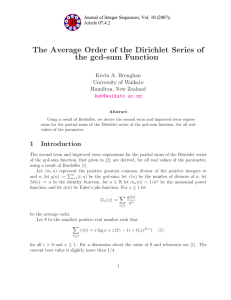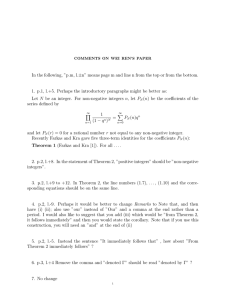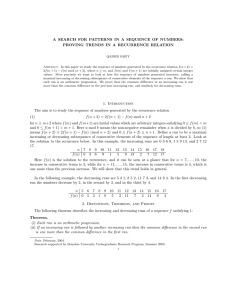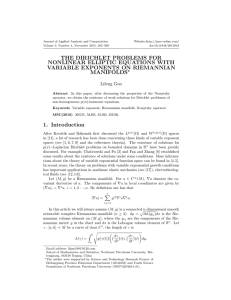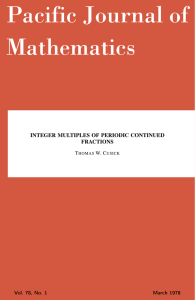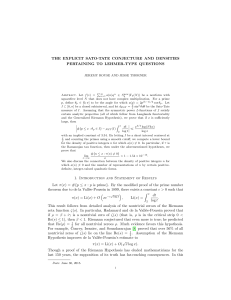A remark on product of Dirichlet
advertisement
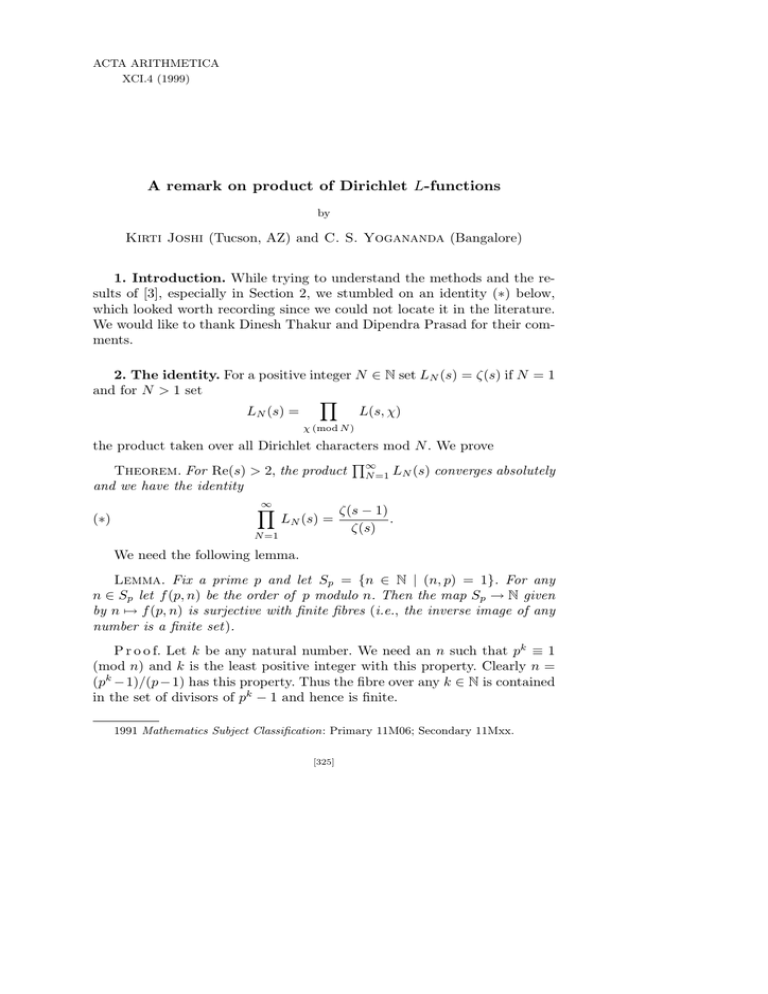
ACTA ARITHMETICA
XCI.4 (1999)
A remark on product of Dirichlet L-functions
by
Kirti Joshi (Tucson, AZ) and C. S. Yogananda (Bangalore)
1. Introduction. While trying to understand the methods and the results of [3], especially in Section 2, we stumbled on an identity (∗) below,
which looked worth recording since we could not locate it in the literature.
We would like to thank Dinesh Thakur and Dipendra Prasad for their comments.
2. The identity. For a positive integer N ∈ N set LN (s) = ζ(s) if N = 1
and for N > 1 set
Y
LN (s) =
L(s, χ)
χ (mod N )
the product taken over all Dirichlet characters mod N . We prove
Q∞
Theorem. For Re(s) > 2, the product N =1 LN (s) converges absolutely
and we have the identity
(∗)
∞
Y
LN (s) =
N =1
ζ(s − 1)
.
ζ(s)
We need the following lemma.
Lemma. Fix a prime p and let Sp = {n ∈ N | (n, p) = 1}. For any
n ∈ Sp let f (p, n) be the order of p modulo n. Then the map Sp → N given
by n 7→ f (p, n) is surjective with finite fibres (i.e., the inverse image of any
number is a finite set).
P r o o f. Let k be any natural number. We need an n such that pk ≡ 1
(mod n) and k is the least positive integer with this property. Clearly n =
(pk − 1)/(p − 1) has this property. Thus the fibre over any k ∈ N is contained
in the set of divisors of pk − 1 and hence is finite.
1991 Mathematics Subject Classification: Primary 11M06; Secondary 11Mxx.
[325]
326
K. Joshi and C. S. Yogananda
P r o o f (of the Theorem). For Re(s) > 1, we have ([2], Lemma 6, p. 72)
Y
(1)
LN (s) =
(1 − p−f (p,N )s )−φ(N )/f (p,N )
p-N
where f (p, N ) is the order of p in (Z/N Z)∗ . For brevity, we write f for
fQ(p, N ) whenever there is no cause for confusion. The convergence of
∞
N =1 LN (s) is equivalent to the convergence of the series
X X φ(N )
(2)
p−f (p,N )s .
f (p, N )
N ≥1 p - N
Note that for p - N we have 1 ≤ φ(N )/f (p, N ) ≤ φ(N ) ≤ N . As pf ≡ 1
(mod N ) we see that pf − 1 = kN , for some positive integer k. However,
several different k, N may give rise to the same integer pf − 1. In any case
the number of different k, N corresponds to the number of divisors of pf − 1.
By [1] (Theorem 315, p. 260), we have d(pf − 1) = o((pf − 1)ε ) = o((kN )ε )
for every positive ε and p sufficiently large. Consequently, the series (2) is
majorised by
X 1 X
1
C
s−ε
s−1−ε
k
N
k
for some positive constant C and hence it converges for Re(s) > 2.
Thus we can interchange the product over N and over p in (1). Hence if
we set
Y
Lp (s) =
(1 − p−f s )−φ(N )/f (p,N )
Q
N ≥1, gcd(p,N )=1
Q
we have N LN (s) = p Lp (s).
Now put U = p−s and take the logarithmic derivative of Lp (s) with
respect to U to get
X
d
U f −1
log Lp (s) =
φ(N )
.
dU
1 − Uf
N ≥1, (p,N )=1
By formally writing out geometric series and interchanging order of summations we get
X
X
X
d
(3)
log Lp (s) =
φ(N )
U f m−1 =
al U l−1 ,
dU
m≥1
l≥1
N ≥1, (p,N )=1
P
where al = f (p,N )m=l φ(N ).
Now observe that by the Lemma, for any l ∈ N and a representation
l = f (p, n)m for some n ∈ Sp , m ∈ N (in the notations of the Lemma),
we have a divisor of pl − 1. Conversely, any divisor d of pl − 1 gives a
Product of Dirichlet L-functions
327
representation l = f (p, d)m0 for some m0 . Therefore
X
X
al =
φ(N ) =
φ(d) = pl − 1.
d|pl −1
f (p,N )m=l
Thus we have
X
d
log Lp (s) =
(pl − 1)U l−1 .
dU
l≥1
Then by integrating we see that
Lp (s) =
1 − p−s
1 − p−(s−1)
which proves the Theorem.
References
[1]
[2]
[3]
G. H. H a r d y and E. M. W r i g h t, An Introduction to the Theory of Numbers, 4th
ed., Oxford Univ. Press, 1968.
J.-P. S e r r e, A Course in Arithmetic, Springer International Student Edition, Narosa
Publ. House, New Delhi, 1979.
Y. T a n i y a m a, L-functions of number fields and zeta functions of abelian varieties,
J. Math. Soc. Japan 9 (1957), 330–366.
Mathematics Department
University of Arizona
617 N Santa Rita
P.O. Box 210089
Tucson, AZ 85721, U.S.A.
E-mail: kirti@math.arizona.edu
Indian Institute of Science
Bangalore, India
E-mail: yoga@math.iisc.ernet.in
Received on 3.6.1998
and in revised form on 16.3.1999
(3394)

